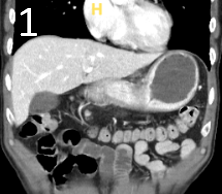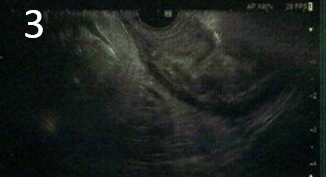Tuesday Poster Session
Category: Stomach and Spleen
P6413 - When Cancer Blocks the Path: A Rare Presentation of GOO From Signet Ring Cell Carcinoma
Tuesday, October 28, 2025
10:30 AM - 4:00 PM PDT
Location: Exhibit Hall

Douglas M. Rivera-Agosto, MD
HCA Florida Blake Hospital
Bradenton, FL
Presenting Author(s)
Douglas M.. Rivera-Agosto, MD1, Aagna M. Patel, DO2, Wilfredo Javier Rojas, DM2, Yizhi Lin, DO1
1HCA Florida Blake Hospital, Bradenton, FL; 2HCA Florida Healthcare, Bradenton, FL
Introduction: This case highlights a rare initial presentation of Signet ring cell carcinoma as Gastric Outlet Obstruction in a young, healthy patient and underscores the importance of diagnostic endoscopy in patients with persistent upper gastrointestinal symptoms. It also draws attention to the critical role of multidisciplinary care coordination and the impact of socioeconomic barriers on cancer outcomes. To our knowledge, reports of SRCC presenting initially as GOO remain limited in the literature, making this case an important contribution to the differential diagnosis of GOO.
Case Description/
Methods: The patient is a 44-year-old Spanish-speaking male that presented with a two-month history of progressive dysphagia and unintentional weight loss. EGD showed retained gastric contents, denuded esophageal mucosa and a thickened gastric wall causing outlet obstruction concerning for an infiltrative gastric malignancy. EUS findings concerning for linitis plastica. Pathology confimed a poorly differentiated gastric adenocarcinoma with signet ring cells. Given the diagnosis of linitis plastica with regional lymph node involvement, he was recommended chemotherapy. The patient was transferred out and underwent diagnostic laparoscopy, port-a-cath placement, and feeding jejunostomy. Intraoperative findings confirmed peritoneal carcinomatosis. Peritoneal biopsies were obtained. Final pathology revealed HER2-positive, microsatellite-stable, poorly differentiated adenocarcinoma with signet ring features. Patient recommended systemic chemotherapy with FOLFOX and trastuzumab.
Discussion: The management of malignant GOO, particularly in the setting of advanced gastric cancer such as SRCC, presents complex therapeutic challenges. Various palliative interventions exist to restore enteral nutrition. In this case, surgical placement of a jejunostomy tube was chosen. Therapeutic decisions in SRCC are often constrained by both tumor biology and patient-specific considerations. Interestingly, this patient’s tumor demonstrated HER2 overexpression, a biomarker found in approximately 15–20% of gastric adenocarcinomas and associated with improved responsiveness to trastuzumab when combined with chemotherapy, as established in the ToGA trial. However, HER2 positivity is notably rare in SRCC, making this case biologically distinct and offering a potentially actionable target despite the generally poor prognosis of this histological subtype. Unfortunately, the tumor was microsatellite-stable, limiting the utility of immunotherapy.

Figure: CT with Mass like thickening in the distal aspect of the stomach & proximal duodenum

Figure: EUS showing Intramural lesion in the body of the stomach.
Disclosures:
Douglas Rivera-Agosto indicated no relevant financial relationships.
Aagna Patel indicated no relevant financial relationships.
Wilfredo Javier Rojas indicated no relevant financial relationships.
Yizhi Lin indicated no relevant financial relationships.
Douglas M.. Rivera-Agosto, MD1, Aagna M. Patel, DO2, Wilfredo Javier Rojas, DM2, Yizhi Lin, DO1. P6413 - When Cancer Blocks the Path: A Rare Presentation of GOO From Signet Ring Cell Carcinoma, ACG 2025 Annual Scientific Meeting Abstracts. Phoenix, AZ: American College of Gastroenterology.
1HCA Florida Blake Hospital, Bradenton, FL; 2HCA Florida Healthcare, Bradenton, FL
Introduction: This case highlights a rare initial presentation of Signet ring cell carcinoma as Gastric Outlet Obstruction in a young, healthy patient and underscores the importance of diagnostic endoscopy in patients with persistent upper gastrointestinal symptoms. It also draws attention to the critical role of multidisciplinary care coordination and the impact of socioeconomic barriers on cancer outcomes. To our knowledge, reports of SRCC presenting initially as GOO remain limited in the literature, making this case an important contribution to the differential diagnosis of GOO.
Case Description/
Methods: The patient is a 44-year-old Spanish-speaking male that presented with a two-month history of progressive dysphagia and unintentional weight loss. EGD showed retained gastric contents, denuded esophageal mucosa and a thickened gastric wall causing outlet obstruction concerning for an infiltrative gastric malignancy. EUS findings concerning for linitis plastica. Pathology confimed a poorly differentiated gastric adenocarcinoma with signet ring cells. Given the diagnosis of linitis plastica with regional lymph node involvement, he was recommended chemotherapy. The patient was transferred out and underwent diagnostic laparoscopy, port-a-cath placement, and feeding jejunostomy. Intraoperative findings confirmed peritoneal carcinomatosis. Peritoneal biopsies were obtained. Final pathology revealed HER2-positive, microsatellite-stable, poorly differentiated adenocarcinoma with signet ring features. Patient recommended systemic chemotherapy with FOLFOX and trastuzumab.
Discussion: The management of malignant GOO, particularly in the setting of advanced gastric cancer such as SRCC, presents complex therapeutic challenges. Various palliative interventions exist to restore enteral nutrition. In this case, surgical placement of a jejunostomy tube was chosen. Therapeutic decisions in SRCC are often constrained by both tumor biology and patient-specific considerations. Interestingly, this patient’s tumor demonstrated HER2 overexpression, a biomarker found in approximately 15–20% of gastric adenocarcinomas and associated with improved responsiveness to trastuzumab when combined with chemotherapy, as established in the ToGA trial. However, HER2 positivity is notably rare in SRCC, making this case biologically distinct and offering a potentially actionable target despite the generally poor prognosis of this histological subtype. Unfortunately, the tumor was microsatellite-stable, limiting the utility of immunotherapy.

Figure: CT with Mass like thickening in the distal aspect of the stomach & proximal duodenum

Figure: EUS showing Intramural lesion in the body of the stomach.
Disclosures:
Douglas Rivera-Agosto indicated no relevant financial relationships.
Aagna Patel indicated no relevant financial relationships.
Wilfredo Javier Rojas indicated no relevant financial relationships.
Yizhi Lin indicated no relevant financial relationships.
Douglas M.. Rivera-Agosto, MD1, Aagna M. Patel, DO2, Wilfredo Javier Rojas, DM2, Yizhi Lin, DO1. P6413 - When Cancer Blocks the Path: A Rare Presentation of GOO From Signet Ring Cell Carcinoma, ACG 2025 Annual Scientific Meeting Abstracts. Phoenix, AZ: American College of Gastroenterology.
